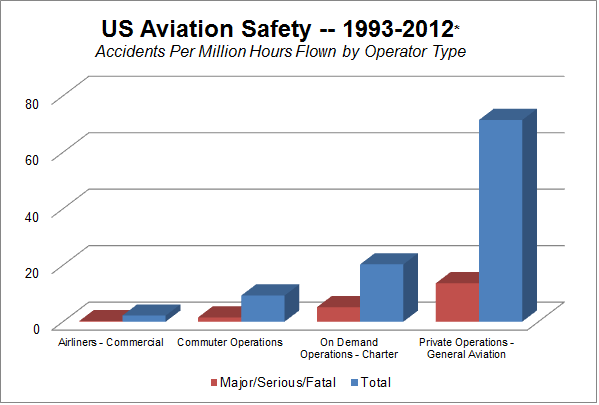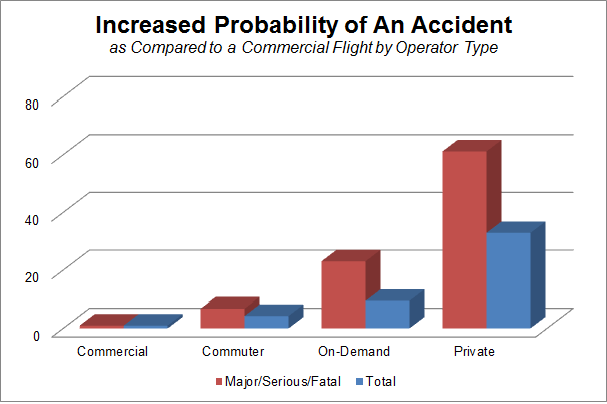While air travel is a remarkably safe mode of transportation–far fewer aviation fatalities than automobile fatalities occur each year, both in terms of actual numbers and per vehicle-miles traveled–the safety of such travel is inextricably linked to the safety of the aircraft and its operators. Travel on commercial airlines affords passengers substantial protections, including extensive, ongoing pilot/crew training requirements; strict fitness-for-flight policies on pilots/crew; regular, qualified aircraft maintenance, broad safety standards, and close oversight by the Federal Aviation Administration (FAA) and Department of Transportation (DOT) in the USA and the European Aviation Safety Agency (EASA) as the blanket regulatory agency over the EU.
Unlike commercial carriers, charter aviation ventures and private pilots are subject to much less regulatory (and consumer) scrutiny. The FAA and DOT aim to review and enforce best practices among aircraft operators; however, there is no governmental quality rating for these entities. Therefore, passengers generally engage a private jet or charter service at their own risk. Additionally, the safety of traveling in chartered and privately operated aircraft falls far short of what passengers of commercial aircraft can expect; the numbers of accidents and fatalities bear this out: over the past 20 years, charter and private aircraft have a far greater probability of crashing over commercial airliners–9.4 times and 32.9 times, respectively (see charts below).
Due to the limited external scrutiny of charter operators, it becomes incumbent upon users to be informed about best practices for safety and protections and to do ample research before engaging a charter operator. Because pilot error accounts for over 50% of fatal airplane crashes, it is important to select operators who have rigorous training and rest requirements for their pilots. Other material causes of crashes include mechanical failure, weather, and sabotage; these risks can be mitigated by excellent maintenance and airframe upkeep, strict procedures for adverse weather conditions, and ample security. Particular areas on which to focus your efforts include certification; safety, security, and maintenance history; pilot requirements; and location-specific expertise.
Certification & Insurance
Within the US, charter aircraft operators that provide transport services for-hire must be certificated by the FAA. The FAA's air carrier certification process helps the agency ensure that certificated entities are able to "design, document, implement, and audit critical safety processes." The type of certificate a flight operates under is dictated by how it's being used and how many passengers; certificates for larger planes and those being used for transport services have more stringent safety and compliance standards. Copies of the certificate, the FAA DO-86 (authorized aircraft document), and evidence of current hull and liability insurance for the tail numbers to be flown should all be requested in advance of a contract signing. Guidelines for limit requirements and best practices can be found below under University Policy.
Safety, Security, & Maintenance History
The single most important risk mitigation step a potential charter user can take is to research the audit history, ratings, and accidents or recordable incidents of any potential charter operator. The charter operator should be able to provide audit ratings, or you may be directed to third-party safety auditors (e.g., International Standard for Business Aircraft Operations (IS-BAO), Air Charter Safety Foundation (ACSF), Aviation Research Group U.S. (ARG/US), Wyvern. etc.)
Good questions to consider during the research process include: Does the operator have any accidents or incidents in its history? How long has the operator been in business under its current name? What is its fleet size and scale and scope of its operations? How frequently are safety inspections conducted, and how many were failed in recent years? Has the operator or its flight crew ever received an FAA Enforcement Action or Letter of Correction?
Additionally, as charter passengers and crew typically do not pass through traditional security procedures, as in commercial terminals, operators should have documented security protocols, including background checks for all employees, security systems and/or personnel where the aircraft are hangared, ID checks of passengers, etc.
Regular, proper maintenance and care of the aircraft is another key component to safe operations.. The FAA approves the maintenance programs for all aircraft operating on air charter operations specifications; however, passengers should still confirm who is responsible for maintaining the operator's fleet: whether it is a factory service center, an in-house mechanic, a local repair facility, or some combination thereof. Factory maintenance is the most reliable, as those technicians are regularly trained in their particular aircraft. When this isn't the case, it is good to determine how often the maintenance technicians are sent for training specific to the aircraft make and model being operated and, when flying an older model, when the pilot’s instruments and navigation equipment (called aircraft avionics) been most recently updated to current technologies. An SMS (Safety Management System) is the newest comprehensive safety program being adopted by the industry.
It is wise to require operators to provide detailed information about their safety, security, and maintenance programs for review in advance of engagement.
Some operators routinely broker other aircraft to fly charters for them, especially during peak travel times. In these instances the operator may have little control over the quality standards of the brokered aircraft. Since the passenger should not have to do additional research on the quality of operations of a brokered flight, operators who engage others' aircraft should be avoided or explicitly contracted to maintain operational control of all flights.
Pilot requirements
Pilot and crew flight experience, in general, and the total number of hours in the particular make/model of aircraft, in particular, are the primary drivers of a safe, successful charter journey. The highest FAA rating a pilot can earn is an airline transport pilot (ATP) rating, which requires a minimum of 1,500 hours flight experience. It is acceptable to pair newer crew members building up their total number of hours with more experienced pilots, as long as the left-seat (lead pilot) has sufficient experience. Because fatigue is one of the major components of pilot error, the most common cause of fatal crashes, the FAA mandates the maximum number of flight and duty time and requires crew rest periods. Operator policy on flight crew training and adequate rest periods are critical to mitigating the chances of an unfortunate event. At a minimum, operators should be able to document their adherence to the FAA standards and to track their pilots compliance, while some may go above and beyond these standards.
Many charter operators also train their pilots and flight attendants in emergency procedures like first aid and CPR for the rare instances when emergencies arise or passengers need medical attention during a charter flight. In addition, some aircraft operators carry a defibrillator (AED) on board and/or subscribe to an in-flight medical assistance program to provide additional medical assistance to passengers in the event it is needed. Ideally, one or more flight crew members will be trained in emergency procedures, first aid, CPR, the proper used of an AED, and aircraft-specific emergency egress.
International & Exotic Locale Expertise
Because regulations differ from country to country, it is important that any operator and flight crew being engaged to fly international routes has experience flying to, from, and within the countries being visited. Additionally, you should determine what specific safety and security processes the operator undertakes, especially if there are security concerns with particular destinations, and if the operator is capable of assisting with logistical concerns, such as immigration and customs requirements. Moreover, for trips that require specialized expertise, such as mountain airports, polar expeditions, extended journeys over water, or flights into airports with distinct operating features, such as a particularly steep approach or shorter-than-standard runway, the expertise of the operator and flight crew should be researched, including how often they train for and conduct these and similar flights.
Charter Brokers
Some charter passengers prefer to contract directly with a flight operator while others prefer to work through a charter broker. Brokers typically have an industry-wide reach and can connect passengers with a variety of charter operators who meet their criteria. Additionally, brokers can often assist with much of the research work noted above. However, because there is essentially no regulation or oversight of those calling themselves air charter brokers, research into the broker's history and operations should be conducted, including company personnel and their expertise in aviation, how long the broker has operated under the current name, if any complaints or lawsuits have been filed against the broker, etc. Additionally, documentation supporting their operations should be requested, including evidence of Professional Liability/Errors & Omissions insurance, copies of the IRS Form 720, Federal Excise Tax deposits and filings, and its D-U-N-S number, Dun & Bradstreet rating, or other registered credit history verification.
University Policy
Due to the safety concerns noted above, the University discourages use of chartered aircraft; however, we understand that there are occasions for which no viable transportation option exists in the commercial market. The University does not purchase insurance coverage for any aviation risks, but the Risk Financing and Insurance department is available to assist travelers in assessing the risk information collected, reviewing potential contracts for favorable indemnity and insurance requirements, and providing access to the aviation liability insurance market, which may be important for protecting the tub and University from financial loss, depending on the contractual requirements. Best practices dictate that proof of adequate liability insurance be provided, in advance, by the aircraft owners/operators and the University be listed as an Additional Insured on this policy. Minimum liability limits of $25 million for light turboprop aircraft, $50 million for light jet aircraft (41,000 lbs. or less certified takeoff weight–typically less than 10 passengers), and a minimum of $3 million per seat for large craft are strongly recommended. Because the University's master programs do not cover aviation risks, the financial impact of any loss will likely be borne entirely by the sponsoring tub/department. These best practices and recommendations are in place to help users assess and mitigate the risks of engaging charter and private aircraft.

